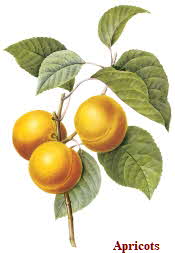APRICOTS, THE PRECOCIOUS FRUIT  --- Recipe below --- Recipe below What does Alexander the Great, King Henry VIII, the Spanish explorers and the English settlers all have in common? The members of this motley crew each played a role in spreading the apricot around the globe. The apricot probably originated in China, at least 4,000 years ago. However, their heritage also extends back thousands of years in Armenia and India as well. In any event, Asia is the indisputable continent of their genesis. Alexander the Great is credited with introducing them to Greece. King Henry VIII’s gardener brought them to England from Italy. English settlers subsequently carried them to Virginia while the Spanish introduced them to the American west coast. 
The apricot, a member of the rose family, is related to plums, peaches, cherries and almonds. All of these fruits are known as drupes, a fruit with thin skin, a pulpy middle, and a hard center enclosing a seed. Apricots ripen earlier then other fruits, a feature which prompted the Romans to call apricot trees praecocia, which translates as precocious. The term praecocia morphed over the centuries into the word apricot.
There are many different varieties of apricot. They range in color from pale yellow to a deep, burnt orange. They prefer a continental climate with slightly cooler temperatures. Currently they are grown throughout the world. Turkey is the largest global producer while California leads US production. Fresh American apricots begin to become available in the US in June. However, apricots from Chile can be found in supermarkets as early as March. Apricots are highly perishable and therefore drying them is an age-old method of preserving them. Dried apricots can be found in most supermarkets year round. Dried apricots are treated with sulfur dioxide to retain their color. When choosing fresh apricots look for specimens that are plump, firm, and devoid of any undue blemishes.
Apricots that are somewhat soft yield the best flavor but must be consumed promptly. Apricots ripen at room temperature. Thus, if they are firm when purchased leave them on the counter until they soften. They can then be stored in a bag in the refrigerator but should be eaten within a couple days.
Like countless foods over the ages, apricots have been alleged to treat all sorts of medical conditions. Apricots, at one time or another, have been lauded to treat cancer, tumors, swelling, ulcers, constipation, diarrhea, and heart disease. Historically they have played a significant role in Chinese medicine where they are thought to regenerate and detoxify the body. What is certain is that apricots are a good source of vitamins A and C, potassium, calcium, iron and beta-carotenes.
Apricots have a wide range of culinary uses. They make a delicious and healthy snack both in fresh and dried forms. Diced dried apricots make a wonderful complement to salads, cereals, yogurt, or any other concoction amenable to the addition of dried fruit. They can be made into a paste and/or employed in stuffings or pureed and fabricated into a sauce. They are also utilized to flavor liqueurs such as the renowned apricot brandy. Apricots can also be cooked. Slice them in half, brush them with honey and grill them until browned. Or to broil them, again slice them in half, and drizzle them with honey or sprinkle with sugar and/or other spices such as cinnamon. Broil them until seared as on the grill. Apricots can also be poached in water, wine or fruit juice that is augmented with spices. Poach them until they become tender, about 6-8 minutes. Remove the apricots, reduce the poaching liquid to render it more syrupy and then use it as a sauce. Below is my recipe for an apricot glaze. Use it to glaze a ham, pork roast, or even duck.
The skin of the apricot is completely edible. If you prefer to peel them, drop them in a pot of boiling water for 20 seconds or so, and then submerge them in a bath of ice water. Allow them to cool and then use your fingers to wipe off the skin.
RECIPEAPRICOT GLAZEINGREDIENTS · 6 apricots
· 3 to 4 tablespoons butter
· 2/3 cup apricot jelly
· 1/4 cup apricot brandy
· 1½ tablespoons rice vinegar
· 1½ teaspoons Dijon mustard
DIRECTIONS
Pit the apricots and then chop them into a small dice.
Cook the apricots in the butter until completely softened.
Stir in remaining ingredients and continue to cook until thickened.
If you like, you can add some honey or sugar if you prefer a sweeter glaze.
Food for Thought - May 11, 2011 - Mark R. Vogel - Epicure1@optonline.net - Mark’s Archive | 